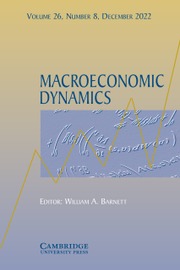No CrossRef data available.
Article contents
A note on optimal foreign reserve management without commitment
Published online by Cambridge University Press: 11 August 2025
Abstract
This paper examines optimal policy for foreign exchange (FX) reserve management without commitment. The stylized linear-quadratic model incorporates three key elements: (i) fear of floating, (ii) forward-looking exchange rates, and (iii) the cost of reserve management. The paper first analyzes two benchmark optimal policies: the Ramsey policy (with commitment) and the Markov-Perfect policy (without commitment). It then proposes a sustainable plan that addresses the time inconsistency in reserve management. By following this plan, the government without commitment achieves the Ramsey outcome in equilibrium.
Keywords
Information
- Type
- Notes
- Information
- Copyright
- © The Author(s), 2025. Published by Cambridge University Press
References
Abreu, D., Pearce, D. and Stacchetti, E. (1990). Toward a theory of discounted repeated games with imperfect monitoring. Econometrica: Journal of the Econometric Society 58(5), 1041–1063.10.2307/2938299CrossRefGoogle Scholar
Arce, F., Bengui, J. and Bianchi, J.. (2019). A Macroprudential Theory of Foreign Reserve Accumulation, Working Paper 26236, National Bureau of Economic Research.10.21034/wp.761CrossRefGoogle Scholar
Barro, R.J. and Gordon, D.B.. (1983). Rules, discretion and reputation in a model of monetary policy. Journal of Monetary Economics 12(1), 101–121.10.1016/0304-3932(83)90051-XCrossRefGoogle Scholar
Basu, S.S., Ghosh, A.R., Ostry, J.D. and Winant, P.E.. (2018). Managing capital outflows with limited reserves. IMF Economic Review 66(2), 333–374.10.1057/s41308-018-0055-7CrossRefGoogle Scholar
Bianchi, J. and Lorenzoni, G.. (2022). The prudential use of capital controls and foreign currency reserves. In Handbook of International Economics, Vol. 6, pp. 237–289, Elsevier.Google Scholar
Calvo, G.A. (1978). On the time consistency of optimal policy in a monetary economy. Econometrica: Journal of the Econometric Society 46(6), 1411–1428.10.2307/1913836CrossRefGoogle Scholar
Calvo, G.A. and Reinhart, C.M.. (2002). Fear of floating. The Quarterly Journal of Economics 117(2), 379–408.10.1162/003355302753650274CrossRefGoogle Scholar
Céspedes, L.F. and Chang, R.. (2024). Optimal foreign reserves and central bank policy under financial stress. American Economic Journal: Macroeconomics 16(3), 230–267.Google Scholar
Chang, R. (1998). Credible monetary policy in an infinite horizon model: recursive approaches. Journal of Economic Theory 81(2), 431–461.10.1006/jeth.1998.2395CrossRefGoogle Scholar
Chari, V.V. and Kehoe, P.J.. (1990). Sustainable plans. Journal of Political Economy 98(4), 783–802.10.1086/261706CrossRefGoogle Scholar
Evans, D. and Sargent, T.J.. (2013). History-dependent public policies. In T. J. Sargent & J. Vilmunen (Eds.), Macroeconomics at the Service of Public Policy (pp. 120–140). Oxford University Press.10.1093/acprof:oso/9780199666126.003.0008CrossRefGoogle Scholar
Gabaix, X. and Maggiori, M.. (2015). International liquidity and exchange rate dynamics. The Quarterly Journal of Economics 130(3), 1369–1420.10.1093/qje/qjv016CrossRefGoogle Scholar
Ghosh, A.R., Ostry, J.D. and Chamon, M.. (2016). Two targets, two instruments: monetary and exchange rate policies in emerging market economies. Journal of International Money and Finance 60, 172–196.10.1016/j.jimonfin.2015.03.005CrossRefGoogle Scholar
International Monetary Fund. (2011). Assessing reserve adequacy. IMF Policy Paper, (Washington: International Monetary Fund).Google Scholar
International Monetary Fund. (2013). Assessing reserve adequacy-further considerations. IMF Policy Paper, (Washington: International Monetary Fund).Google Scholar
Jeanne, O. and Rancière, R.. (2011). The optimal level of international reserves for emerging market countries: a new formula and some applications. The Economic Journal 121(555), 905–930.10.1111/j.1468-0297.2011.02435.xCrossRefGoogle Scholar
Kydland, F.E. and Prescott, E.C.. (1980). Dynamic optimal taxation, rational expectations and optimal control. Journal of Economic Dynamics and Control 2, 79–91.10.1016/0165-1889(80)90052-4CrossRefGoogle Scholar
Patel, N. and Cavallino, P.. (2019). FX intervention: goals, strategies and tactics. BIS Paper, No. 104b.Google Scholar
Phelan, C. and Stacchetti, E.. (2001). Sequential equilibria in a Ramsey tax model. Econometrica 69(6), 1491–1518.10.1111/1468-0262.00255CrossRefGoogle Scholar
Stokey, N.L. (1989). Reputation and time consistency. The American Economic Review 79(2), 134–139.Google Scholar
Stokey, N.L. (1991). Credible public policy. Journal of Economic Dynamics and Control 15(4), 627–656.10.1016/0165-1889(91)90036-ZCrossRefGoogle Scholar

